Review of Printed Log-Periodic Dipole Array Antenna Design for EMC Applications
Abstract
1. Introduction
2. Design of PLPDA Antenna
3. Literature Review of Several PLPDA Antennas for EMC Applications
4. Specifications of Antenna Design for EMC Applications
4.1. Size Reduction (SR%)
4.1.1. Test Configuration Issue
4.1.2. Short Measurement Distance
- Using a power amplifier to increase the power level at the UFA.
- Using another antenna to get the maximum field strength. This option is not recommended because having many antennae inside the EMC chamber will affect the measurement results.
- Shorting the measurement distance (the distance between the reference antenna and the device under the test), the problem is that the immunity test should be performed in the far field and shortening this distance will make the measurement in the near field, and the measurement results will not be valid. The biggest dimension of the antenna determines the starting point of the far-field area. However, the reference antenna with a compact size has a starting point of the far-field area closer to the compact antenna than the classical antenna. This antenna gives the flexibility of shortening the measurement distance to achieve the required field strength and guarantees the measurements will be performed in the far-field area.
4.2. Bandwidth Enhancement
4.3. Antenna Factor (AF)
4.4. The Half Power Beamwidth Angle (θ3dB)
5. Discussion and Recommendations
- The wide bandwidth: the proposed PLPDA antenna must have a wide bandwidth where Fmax/Fmin > 10 so that the impedance and radiation characteristics remain constant as a frequency function, which is why it is called a frequency-independent antenna [42].
- The majority of EMC antennas are designed to operate within the 0.7 GHz to 2.4 GHz frequency range, as it encompasses several widely used applications such as GSM (850–900 MHz), mobile networks (1800 MHz), 3G (2100 MHz), and Wi-Fi (2400 MHz), making it highly susceptible to interference. Furthermore, increasing the bandwidth to 6 GHz is essential to catch the interference emitted from Wi-MAX 3.5 GHz and 5.3 GHz, PAN 4.8 GHz, and WLAN 5.8 GHz applications [43].
- The compact size of the printed antenna will achieve the maximum field strength at the UFA during the immunity test and will satisfy the test configuration issue.
- The antenna should have a steady phase center where the polarization of the radiation pattern will stay constant with the frequency [44].
- The axial ratio (AR) is an essential factor in identifying the antenna’s polarization type, linear, elliptical, or circular polarization. The reference antenna is required to be linearly polarized according to the EMC community [45]. The range from 0 to 3 dB value of AR is dedicated to the circular polarization. The elliptical polarization starts from AR with 3 dB up to infinity, and the infinity value of AR stands for the linear polarization. Currently, no practical or industrial standard exists to distinguish elliptically polarized antennas from linearly polarized ones based solely on axial ratio. As a result, linear polarization can be considered a special case of elliptical polarization [46].
- Unfortunately, a slight deviation in the polarization will occur from the intended design for one reason or another. For instance, even the log-periodic dipole array antenna with a unique distribution of linear dipoles exhibits elliptical polarization instead of linear polarization [47].
- The co-and cross polarization of radiation pattern for both E and H field are necessary aspects and the acceptable level of cross polarization according to EMC standards lies between −14 dB to −20 dB [45].
- The reference antenna for measurement has a high directive characteristic: The flat gain is preferable to a fluctuation gain since it distributes the electromagnetic waves inside the chamber. Moreover, the flat realized gain reflects smooth balance and constant antenna factor.
- The uncertainty of the reference antenna can be determined by finding out the measured error from comparison the measured radiation incident field of the proposed antenna with that of commercial design in a process called calibration. Moreover, this maximum difference should compare with the acceptable level of EMC standard [48,49].
- Future work on this topic could be included:
Author Contributions
Funding
Data Availability Statement
Acknowledgments
Conflicts of Interest
References
- Abdulhameed, A.A.; Alhamdawee, E.M.; Hayder, I.M. Review of reconfigurable/UWB antenna for interweave cognitive radio applications. Aust. J. Electr. Electron. Eng. 2019, 16, 96–101. [Google Scholar] [CrossRef]
- Abdulhameed, A.A.; Kubik, Z. Investigation of Broadband Printed Biconical Antenna with Tapered Balun for EMC Measurements. Energies 2021, 14, 4013. [Google Scholar] [CrossRef]
- Alnahwi, F.M.; Abdulhameed, A.; Abdullah, A.S. A Compact Integrated UWB/Reconfigurable Microstrip Antenna for Interweave Cognitive Radio Applications. Int. J. Commun. Antenna Propag. (IRECAP) 2018, 8, 13078. [Google Scholar] [CrossRef]
- Alnahwi, F.M.; Abdalhameed, A.A.; Swadi, H.L.; Abdullah, A.S. A compact wide-slot UWB antenna with reconfigurable and sharp dual-band notches for underlay cognitive radio applications. Turk. J. Electr. Eng. Comput. Sci. 2019, 27, 94–105. [Google Scholar] [CrossRef]
- Mohammed, A.A.; Alnahwi, F.M.; Abdullah, A.S.; Hameed, A.G.A.A. A Compact Monopole Antenna with Reconfigurable Band Notch for Underlay Cognitive Radio Applications. In Proceedings of the 2018 International Conference on Advance in Sustainable Engineering and Its Application (Icasea), Wasit-Kut, Iraq, 14–15 March 2018; pp. 25–30. [Google Scholar]
- Group, M.V. Considerations in Emi Antenna Design. Available online: http://www.interferencetechnology.com/wp-content/uploads/2021/02/Whitepaper-EMC-Considerations-in-EMI-Antenna-Design.pdf (accessed on 10 January 2023).
- Maddocks, A. 23—Electromagnetic Compatibility. In Electrical Engineer’s Reference Book, 16th ed.; Laughton, M.A., Warne, D.J., Eds.; Newnes: Oxford, UK, 2003; pp. 16–23. [Google Scholar]
- Gifuni, A.; Bastianelli, L.; Gradoni, G.; Moglie, F.; Perna, S.; Smartt, C.; Primiani, V.M. On the Shielding Effectiveness Calculation of Enclosures Through Measurements in Reverberation Chambers. IEEE Trans. Electromagn. Compat. 2021, 63, 1395–1406. [Google Scholar] [CrossRef]
- Kubik, Z.; Skala, J. Shielding Effectiveness Simulation of Small Perforated Shielding Enclosures Using FEM. Energies 2016, 9, 129. [Google Scholar] [CrossRef]
- Lin, F.; Qi, Y.; Fan, J.; Jiao, Y.-C. 0.7–20-GHz Dual-Polarized Bilateral Tapered Slot Antenna for EMC Measurements. IEEE Trans. Electromagn. Compat. 2014, 56, 1271–1275. [Google Scholar] [CrossRef]
- Sapuan, S.Z.; Kazemipour, A.; Mohd Jenu, M.Z. Direct feed biconical antenna as a reference antenna. In Proceedings of the 2011 IEEE International RF & Microwave Conference, Seremban, Malaysia, 12–14 December 2011; pp. 5–8. [Google Scholar]
- Velicheti, S.; Mallikarjuna Rao, P. An Analytical Review on Log Periodic Dipole Antennas with Different Shapes of Dipole Elements. In Microelectronics, Electromagnetics and Telecommunications; Lecture Notes in Electrical Engineering; Springer: Singapore, 2021; pp. 621–631. [Google Scholar]
- Bang, J.; Han, C.; Jung, K.; Choi, J. High-Frequency Performance Improvement of LPDA for EMC/EMI Measurements. In Proceedings of the 2020 International Symposium on Antennas and Propagation (Isap), Osaka, Japan, 25–28 January 2021; pp. 621–622. [Google Scholar]
- Ivsic, B.; Friscic, F.; Dadic, M.; Muha, D. Design and Analysis of Vivaldi Antenna for Measuring Electromagnetic Compatibility. In Proceedings of the 2019 42nd International Convention on Information and Communication Technology, Electronics and Microelectronics (MIPRO), Opatija, Croatia, 20–24 May 2019; pp. 491–495. [Google Scholar]
- Jiang, J.; Pan, S.; Wang, S.; Li, G. Miniaturization Design of VHF Broadband Directional Radiation TEM Horn Antenna. In Proceedings of the 2020 International Conference on Microwave and Millimeter Wave Technology (ICMMT), Shanghai, China, 20–23 September 2020; pp. 1–3. [Google Scholar]
- Gerber, M.; Odendaal, J.W.; Joubert, J. DRGH Antenna With Improved Gain and Beamwidth Performance. Propagation 2019, 68, 4060–4065. [Google Scholar] [CrossRef]
- Mallahzadeh, A.R.; Pazoki, R.; Karimkashi, S. A new UWB skeletal antenna for EMC applications. In Proceedings of the IEEE 2007 International Symposium on Microwave, Antenna, Propagation and Emc Technologies for Wireless Communications, Vols I and Ii, Hangzhou, China, 16–17 August 2007; p. 543. [Google Scholar]
- Kim, K.C.; Choi, B.J.; Jung, S.W. Characteristics of the Sleeve Dipole Antenna Used for EMC Applications. IEEE Access 2020, 8, 86957–86961. [Google Scholar] [CrossRef]
- Hacene, Y.; Xie, S.G. Study of a Novel Ultra-Wideband Monopole Antenna for EMC Measurement Applications. In Proceedings of the 2012 6th Asia-Pacific Conference on Environmental Electromagnetics (Ceem’ 2012), Shanghai, China, 6–9 November 2012; pp. 393–395. [Google Scholar]
- Kuhn, W.; Peterson, G.; Welch, J. Broadband Antenna Probe for Microwave EMC Measurements. In Proceedings of the 2018 IEEE 27th Conference on Electrical Performance of Electronic Packaging and Systems (EPEPS), San Jose, CA, USA, 14–17 October 2018; pp. 199–201. [Google Scholar]
- Song, Q.; Shen, Z.; Lu, J. Log-Periodic Monopole Array With Uniform Spacing and Uniform Height. IEEE Trans. Antennas Propag. 2018, 66, 4687–4694. [Google Scholar] [CrossRef]
- Hu, Z.; Shen, Z.; Wu, W.; Lu, J. Low-Profile Log-Periodic Monopole Array. IEEE Trans. Antennas Propag. 2015, 63, 5484–5491. [Google Scholar] [CrossRef]
- Abdulhameed, A.A. Circular slotted monopole printed antenna with grounded stub WLAN band-notch for UWB applications. Aust. J. Electr. Electron. Eng. 2018, 14, 59–63. [Google Scholar] [CrossRef]
- DuHamel, R.; Isbell, D. Broadband logarithmically periodic antenna structures. In Proceedings of the 1958 IRE International Convention Record, New York, NY, USA, 21–25 March 1966; pp. 119–128. [Google Scholar]
- Rumsey, V.H. Frequency Independent Antennas. In Proceedings of the 1958 IRE International Convention Record, New York, NY, USA, 21–25 March 1966; Volume 45, p. 385. [Google Scholar]
- Carrel, R. The design of log-periodic dipole antennas. In Proceedings of the IRE International Convention Record, New York, NY, USA, 21–25 March 1966; pp. 61–75. [Google Scholar]
- Balanis, C.A. Antenna Theory: Analysis and Design; John Wiley & Sons: Hoboken, NJ, USA, 2015. [Google Scholar]
- Gupta, N.; Haque, A. Design of printed log periodic EMI sensor. Int. J. Microw. Opt. Technol. 2009, 4, 211–215. [Google Scholar]
- Limpiti, T.; Chantaveerod, A.Y. Design of a printed log-periodic dipole antenna (LPDA) for 0.8–2.5 GHz band applications. In Proceedings of the 2016 13th International Conference on Electrical Engineering/Electronics, Computer, Telecommunications and Information Technology (ECTI-CON), Chiang Mai, Thailand, 28 June 2016–1 July 2016; pp. 1–4. [Google Scholar]
- Yu, L.B.; Chai, S.L.; Huang, H.; Ding, L.; Xiao, K.; Zhao, F. A Printed Log-periodic Dipole Antenna with Balanced Feed Structure. In Proceedings of the 2016 Progress in Electromagnetics Research Symposium (Piers), Shanghai, China, 8–11 August 2016; pp. 2035–2038. [Google Scholar]
- Kyei, A.; Sim, D.U.; Jung, Y.B. Compact log-periodic dipole array antenna with bandwidth-enhancement techniques for the low frequency band. Iet Microw. Antennas Propag. 2017, 11, 711–717. [Google Scholar] [CrossRef]
- Mistry, K.K.; Lazaridis, P.I.; Zaharis, Z.D.; Xenos, T.D.; Tziris, E.N.; Glover, I.A. An optimal design of printed log-periodic antenna for L-band EMC applications. In Proceedings of the 2018 Joint Ieee International Symposium on Electromagnetic Compatibility and 2018 Ieee Asia-Pacific Symposium on Electromagnetic Compatibility (Emc/Apemc), Singapore, 14–18 May 2018; pp. 1150–1155. [Google Scholar]
- Anim, K.; Jung, Y.B. Shortened Log-Periodic Dipole Antenna Using Printed Dual-Band Dipole Elements. IEEE Trans. Antennas Propag. 2018, 66, 6762–6771. [Google Scholar] [CrossRef]
- Mistry, K.K.; Lazaridis, P.I.; Zaharis, Z.D.; Loh, T.H. Design and Optimization of Compact Printed Log-Periodic Dipole Array Antennas with Extended Low-Frequency Response. Electronics 2021, 10, 2044. [Google Scholar] [CrossRef]
- Abdulhameed, A.A.; Kubík, Z. Design a Compact Printed Log-Periodic Biconical Dipole Array Antenna for EMC Measurements. Electronics 2022, 11, 2877. [Google Scholar] [CrossRef]
- Wu, Q.; Ding, X.; Su, D. A Compact Dipole Antenna With Curved Reflector for 1.0–4.2 GHz EMC Measurement. IEEE Trans. Electromagn. Compat. 2015, 57, 1289–1297. [Google Scholar] [CrossRef]
- Sapuan, S.Z.; Herie, F.H.; Jenu, M.Z.M. A New Small Sized Wideband Biconical Antenna For Electromagnetic Compatibility (EMC) Measurements. In Proceedings of the 2016 IEEE Asia-Pacific Conference on Applied Electromagnetics (Apace), Langkawi, Malaysia, 11–13 December 2016. [Google Scholar]
- Sapuan, S.Z.; Jenu, M.Z.M.; Kazemipour, A. Calibration of Calculable Wideband Direct Feed Biconical Antenna for EMC Measurements. In Proceedings of the 2013 Asia-Pacific Symposium on Electromagnetic Compatibility (Apemc), Melbourne, VIC, Australia, 20–23 May 2013. [Google Scholar]
- McLean, J.; Sutton, R.; Hoffman, R. Interpreting antenna performance parameters for EMC applications: Part 3: Antenna Factor. TDK RF Solut. 2004, 18–26. Available online: https://www.tdkrfsolutions.tdk.com/images/uploads/brochures/antenna_paper_part3.pdf (accessed on 10 January 2023).
- Shop, A. HyperLOG® 7060. Available online: https://aaronia.com/en/breitband-antenne-hyperlog7060?srsltid=AfmBOoo_ZMu0VXkpOWGytpv2WWLrRQ8nOa3Ee-hsR3HcGVsc1d604d9p (accessed on 10 January 2023).
- CISPR16-1-2; Specification for Radio Disturbance and Immunity Measuring Apparatus and Methods-Part 1-2: Radio Disturbance and Immunity Measuring Apparatus-Ancillary Equipment-Conducted Disturbances. ASEAN Trade Repository: Hanoi, Vietnam, 2006.
- Koldaş, M. Ultra Wideband Tightly Coupled Reflectarray Antenna. Master’s Thesis, Middle East Technical University, Çankaya/Ankara, Türkiye, 2022. [Google Scholar]
- Sah, S.; Verma, D. 5G Communication Challenges and Opportunities. In Multifunctional MIMO Antennas: Fundamentals and Application; CRC Press: Boca Raton, FL, USA, 2022. [Google Scholar]
- Stutzman, W.L.; Thiele, G.A. Antenna Theory and Design; John Wiley & Sons: Hoboken, NJ, USA, 2012. [Google Scholar]
- Alexander, M.; Salter, M.; Gentle, D.; Knight, D.; Loader, B.; Holland, K. Calibration and Use of Antennas, Focusing on EMC Applications; NPL: London, UK, 2004. [Google Scholar]
- Patre, S.R.; Singh, S.; Singh, S. Effect of dielectric substrate on performance of planar trapezoidal toothed log-periodic antenna. In Proceedings of the 2013 Students Conference on Engineering and Systems (SCES), Allahabad, India, 12–14 April 2013; pp. 1–4. [Google Scholar]
- McLean, J.; Sutton, R.; Hoffman, R. Interpreting Antenna Performance Parameters for EMC Applications: Part 1: Radiation Pattern, ain, and Directivity; TDK RF Solutions: Cedar Park, TX, USA, 2004. [Google Scholar]
- Ghosh, S.; Srivastava, A.K.; Sarkar, B.K. Measurement of radiated emission using different EMI sensors in the laboratory environment. In Proceedings of the International Conference on Electromagnetic Interference & Compatibility, Pittsburgh, PA, USA, 6–10 August 2012; pp. 217–221. [Google Scholar]
- Stecher, M. Uncertainty in RF Emission Measurements: Revision of CISPR 16-4-2. 2009. Available online: https://emc-chap-it.polimi.it/download/MUinEMC_Revision%20of%20CISPR%2016-4-2%20doc.pdf (accessed on 10 January 2023).
- Parizi, S.A.R. Bandwidth Enhancement Techniques. In Trends in Research on Microstrip Antennas; Sudipta Chattopadhyay; IntechOpen: Rijeka, Croatia, 2017. [Google Scholar]
- Herath, H.M.S.M.; Jayasinghe, J.M.J.W.; Uduwawala, D.N. Performance Improvement of Printed Log Periodic Dipole Array Antennas. In Proceedings of the 2021 IEEE 16th International Conference on Industrial and Information Systems (ICIIS), Kandy, Sri Lanka, 9–11 December 2021; pp. 52–57. [Google Scholar]
- Guo, L.; Wang, Z.; Zeng, W.; Hou, S.; Yang, Z.; Liu, Y. A compact and high gain metalens antenna based on impedance matching mechanism. AEU—Int. J. Electron. Commun. 2022, 146, 154113. [Google Scholar] [CrossRef]
- Abdulhameed, A.A.; Kubík, Z. Using of LPDA Antenna for UFA Evaluation in Radiated Immunity Test. In Proceedings of the 2023 International Conference on Applied Electronics (AE), Pilsen, Czech Republic, 6–7 September 2023; pp. 1–4. [Google Scholar]

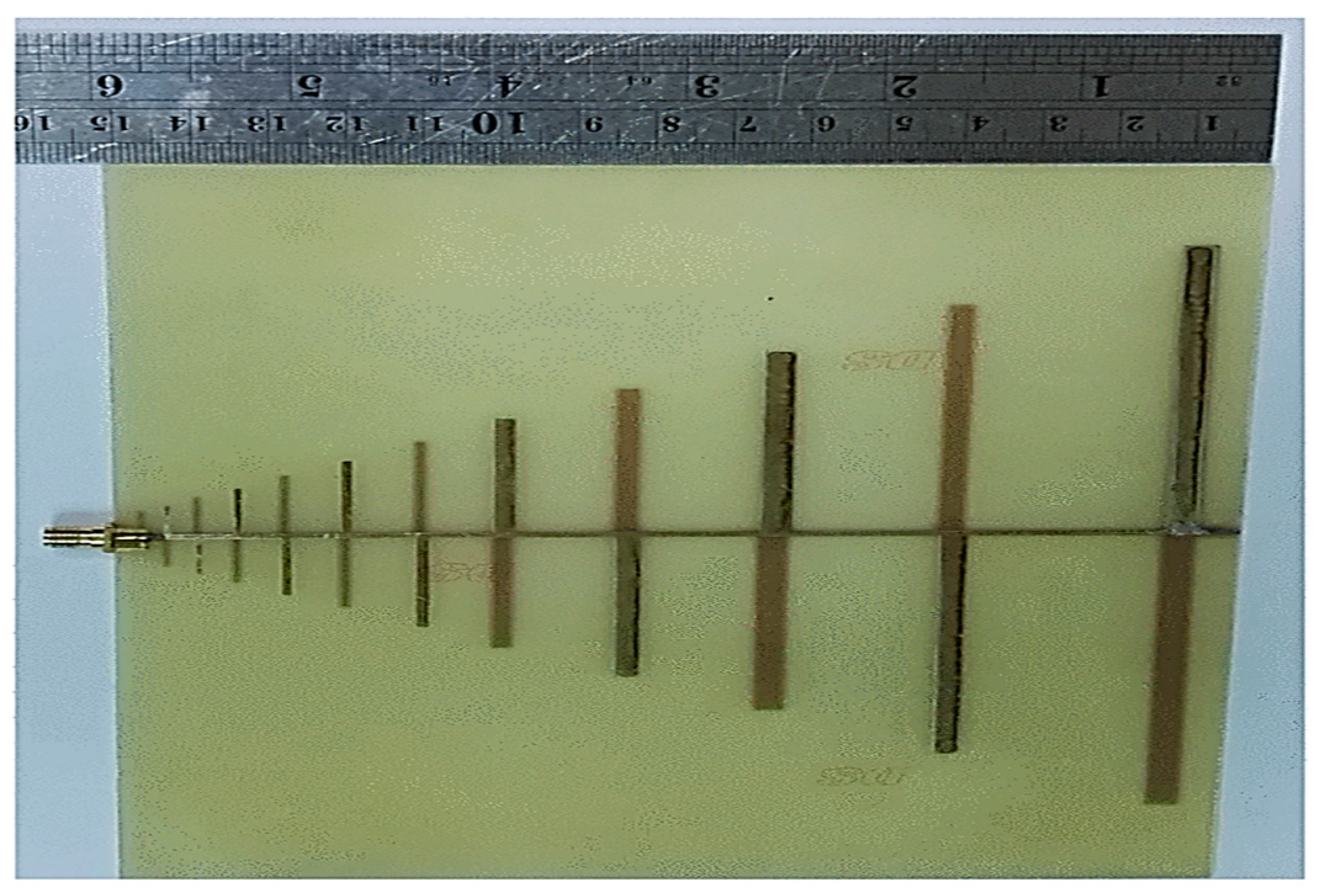

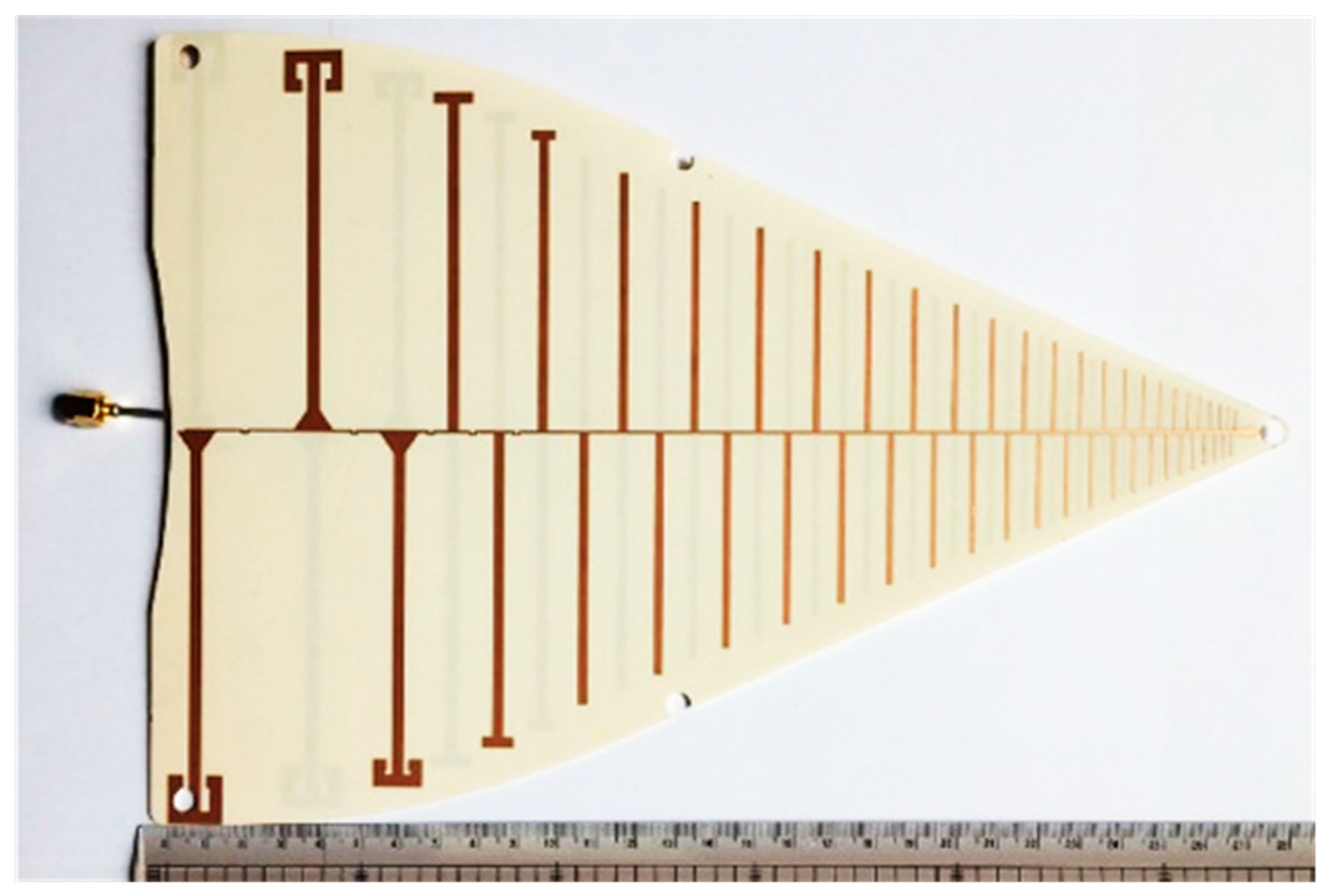
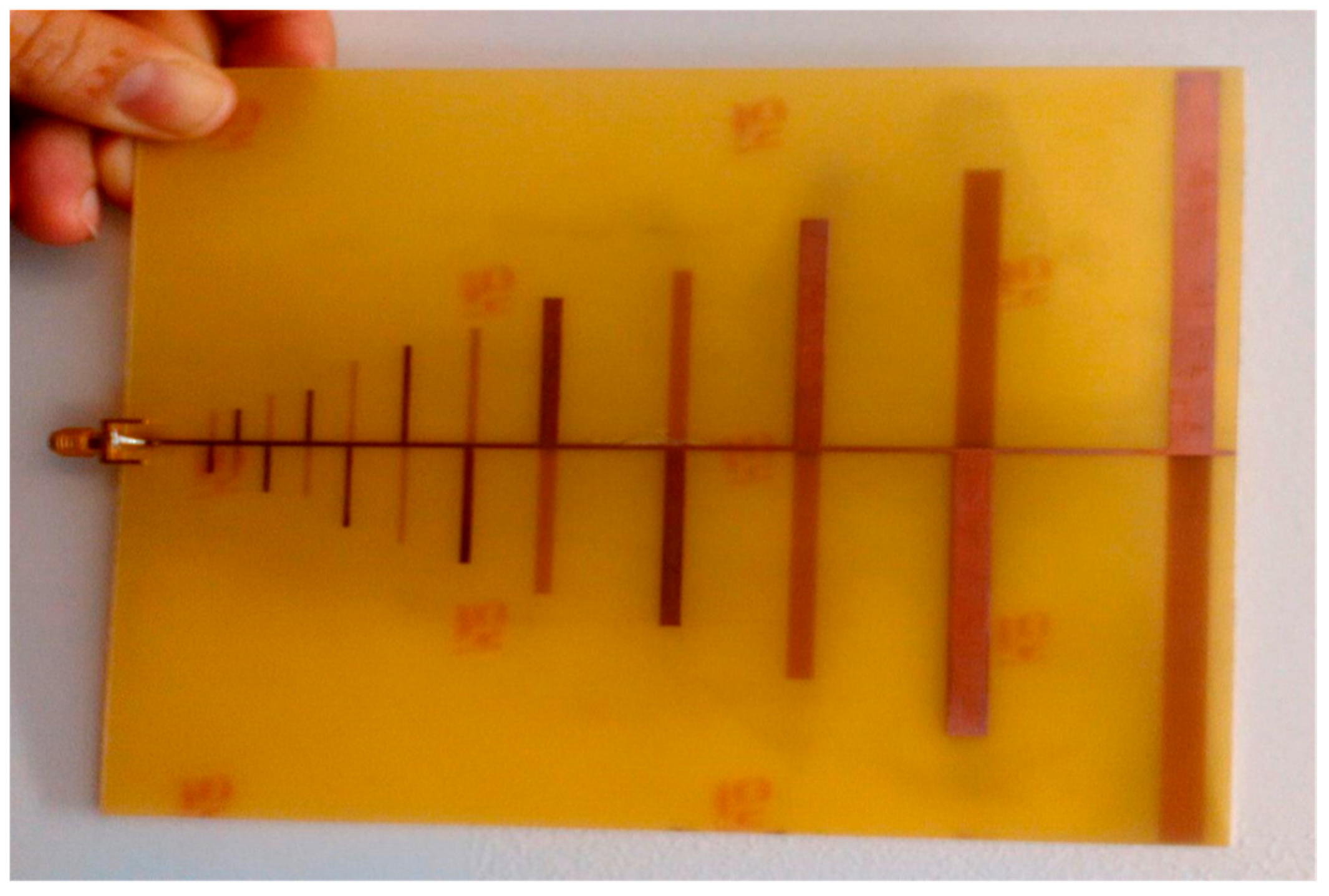
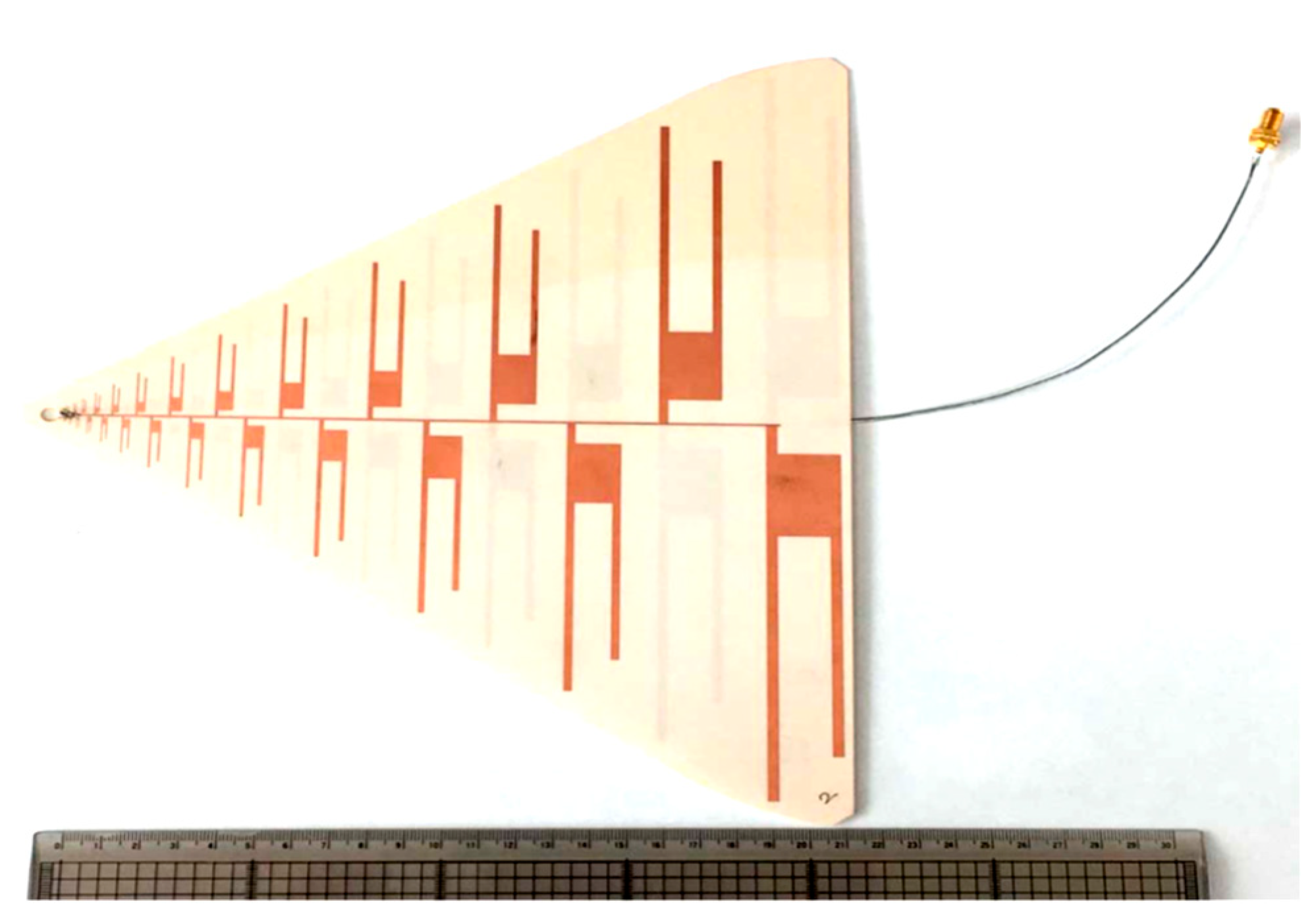
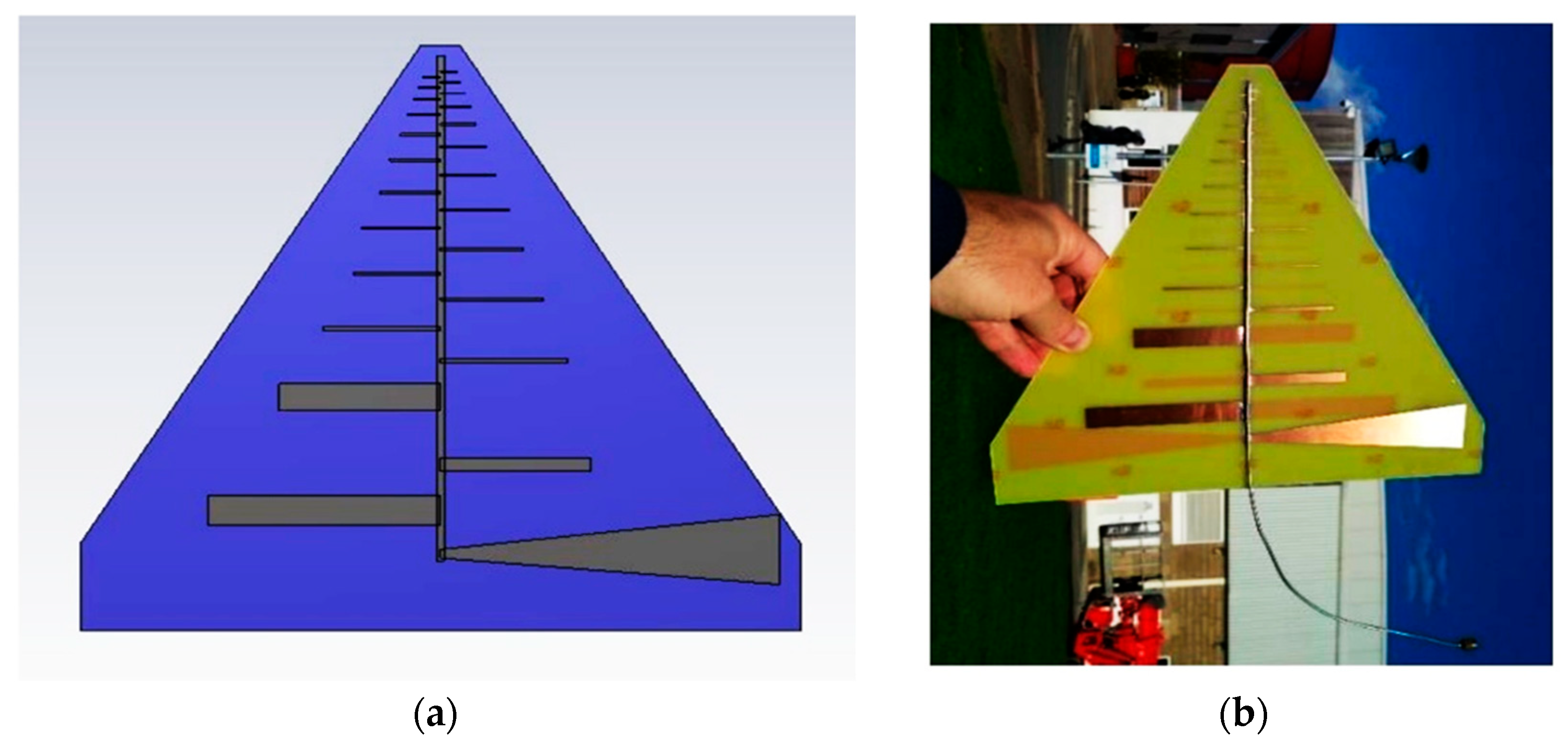
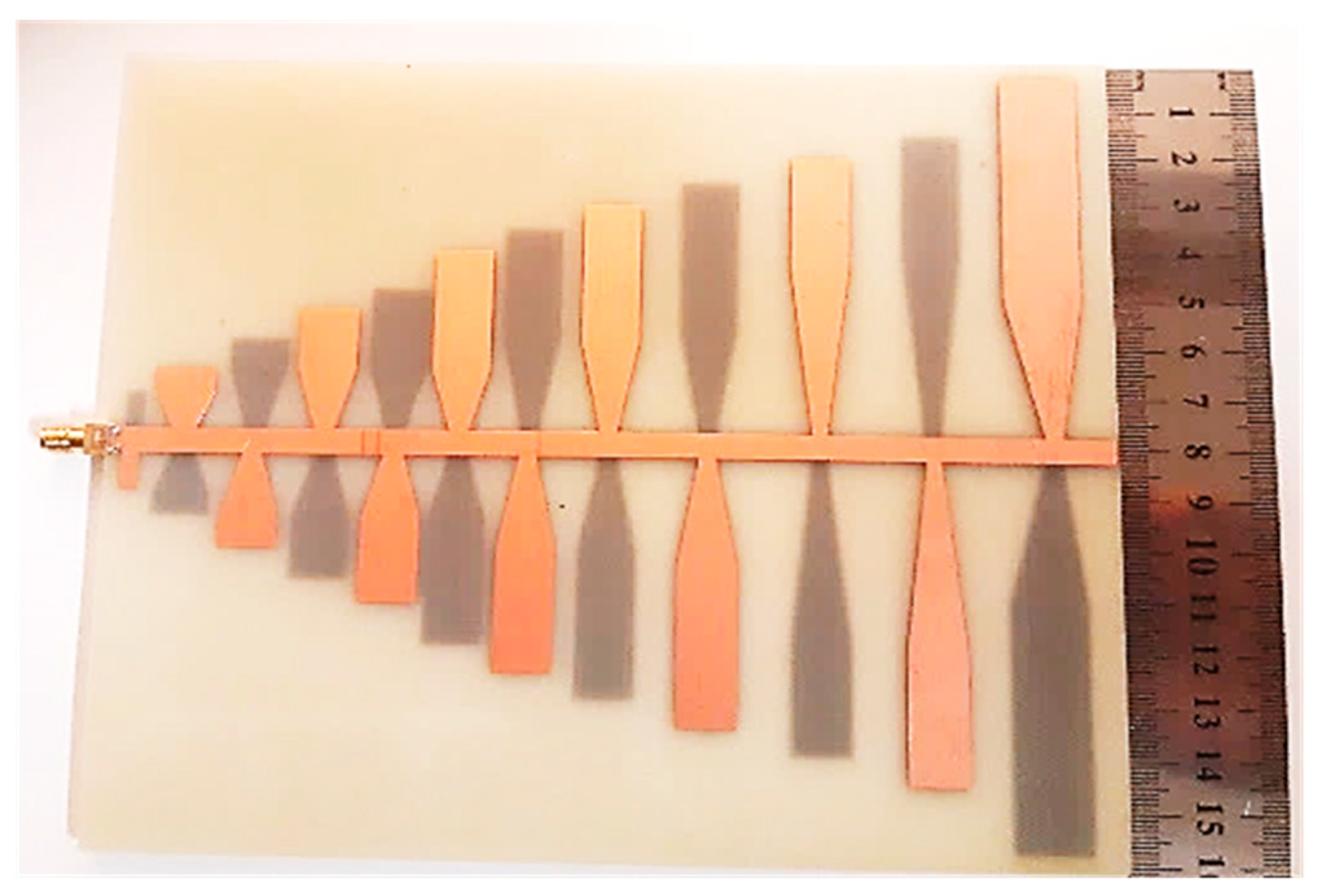

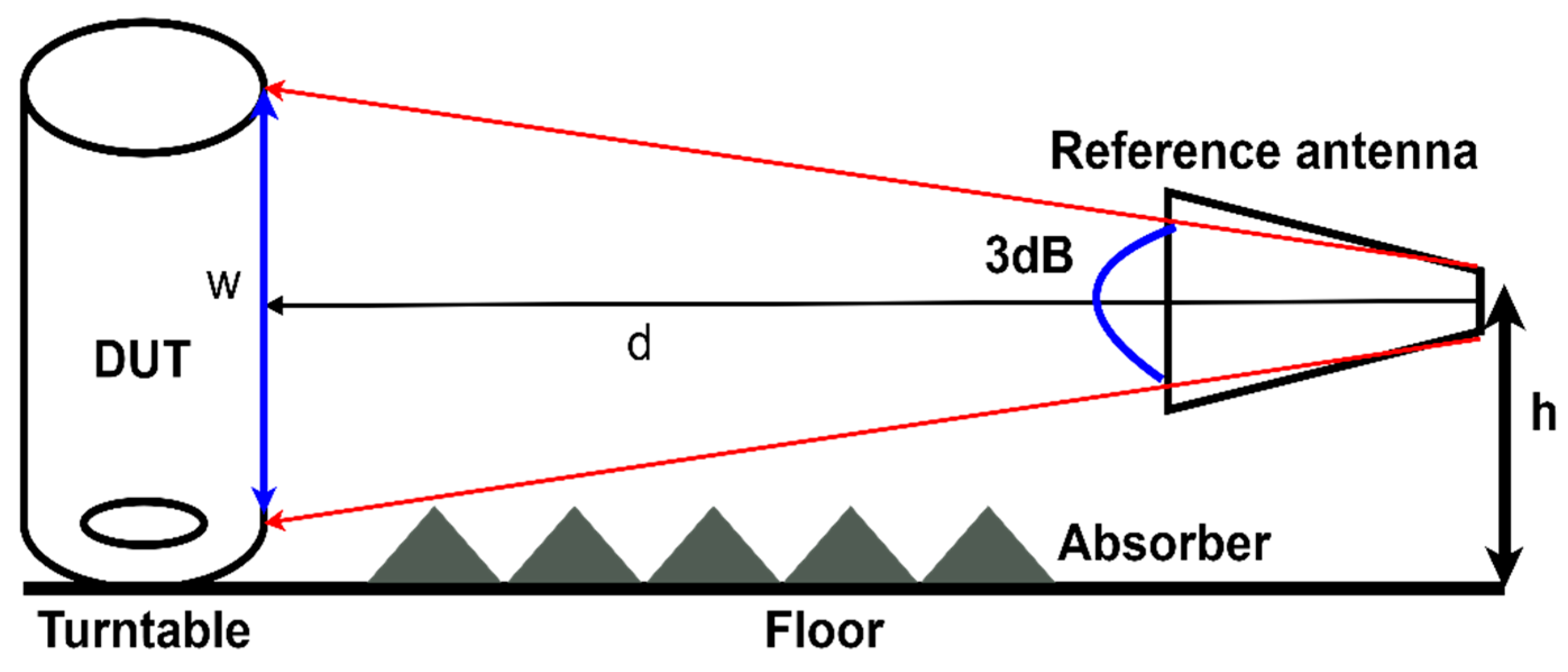
| Ref. | Size of the Proposed PLPDA | Size of the Conventional PLPDA | SR% Boom | SR % Lateral |
|---|---|---|---|---|
| [28] | 206 × 185 × 1.6 | 278 × 251 × 1.6 | 25 | 26 |
| [29] | 160 × 150 × 1.6 | 230 × 164 × 1.6 | 30 | 8.5 |
| [31] | 268 × 194 × 1 | 335 × 265 × 1 | 20 | 27 |
| [32] | 150 × 160 × 1 | 222 × 198 × 1 | 32 | 19 |
| [33] | 218 × 260 × 1 | 364 × 310 × 1 | 40 | 16 |
| [34] | 270 × 279 × 1 | 380 × 300 × 1 | 29 | 7 |
| [35] | 170 × 160 × 1.6 | 340 × 320 × 1.6 | 50 | 50 |
| Ref. | F/GHz | FBW | Gain/dBi | N | Size/λ | Feeding Method | Application | ||
|---|---|---|---|---|---|---|---|---|---|
| [28] | 0.6–2.6 | 125% | 4.3 | ---*1 | 14 dB | 5 | 0.41 × 0.35 | tapered | EMC |
| [29] | 0.8–2.5 | 103% | 4.3 | 0.78 | 6.5 | 12 | 0.42 × 0.4 | Typical | EMC |
| [30] | 0.5–3 | 143% | 4.3 | 0.86 | 7–7.5 | 12 | 0.25 × 0.44 | Balanced | EMC |
| [31] | 0.55–9 | 177% | 3.5 | 0.93 | 2.4–7.8 | 48 | 0.49 × 0.35 | Typical | EMC |
| [32] | 0.8–2.3 | 96.7% | 4.3 | 0.86 | 4.5–6.3 | 12 | 0.42 × 0.37 | Optimized | EMC |
| [33] | 0.5–10 | 181% | 3.5 | 0.91 | 3–6 | 25 | 0.36 × 0.43 | Typical | EMC |
| [34] | 0.7–8 | 180% | 4.3 | 0.9 | 5.5 | 25 | 0.36 × 0.37 | typical | EMC |
| [35] | 0.5–6 | 170% | 4.3 | 0.86 | 4.6–7 | 12 | 0.28 × 0.26 | typical | EMC |
| Freq. | AF [28] | AF [29] | AF [32] | AF [31] | AF [33] | AF [34] | AF [35] | AF [HyperLOG 7060] [40] |
|---|---|---|---|---|---|---|---|---|
| 0.5 | --- | --- | --- | 20 | 20 | 22 | 18.1 | --- |
| 1 | 26 | 25 | 25 | 23 | 25.5 | 29.5 | 24.5 | 26 |
| 1.5 | 29.5 | 28 | 28.5 | 27 | 28.5 | 30 | 28.1 | 29 |
| 2 | 31.9 | 30 | 31.5 | 30 | 31.5 | 30.5 | 31.5 | 31.5 |
| 2.5 | 34 | 31.5 | 32.5 | 32 | 33.5 | 32 | 32.9 | 33 |
| 3 | --- | --- | --- | 34 | 36 | 34 | 34.3 | 35 |
| 3.5 | --- | --- | --- | 35 | 37.5 | 35 | 35.1 | 36.5 |
| 4 | --- | --- | --- | 36 | 39 | 36.5 | 36.2 | 37.25 |
| 4.5 | --- | --- | --- | 37 | 40 | 37 | 37.78 | 37.75 |
| 5 | --- | --- | --- | 37.9 | 41 | 38 | 39.5 | 38.5 |
| 5.5 | --- | --- | --- | 39 | 41.5 | 38.5 | 39.54 | 40.5 |
| 6 | --- | --- | --- | 40 | 42 | 40 | 41.18 | 42 |
| Freq./GHz | θ3dB/° | W/m | θ3dB/° | W/m | θ3dB/° | W/m | θ3dB/° | W/m | θ3dB/° | W/m |
|---|---|---|---|---|---|---|---|---|---|---|
| Ref. | [31] | [31] | [33] | [33] | [34] | [34] | [35] | [35] | CISPR | CISPR |
| 1 | 72 | 1.45 | 48 | 0.89 | 72 | 1.45 | 112 | 2.95 | 60 | 1.15 |
| 2 | ---*1 | ---*1 | ---*1 | ---*1 | 84 | 1.8 | 141 | 4.28 | 55 | 1.04 |
| 4 | 72 | 1.45 | 65 | 1.27 | 83 | 1.76 | 55 | 1.04 | 55 | 1.04 |
| 6 | ---*1 | ---*1 | ---*1 | ---*1 | 66 | 1.3 | 46.4 | 0.85 | 55 | 1.04 |
Disclaimer/Publisher’s Note: The statements, opinions and data contained in all publications are solely those of the individual author(s) and contributor(s) and not of MDPI and/or the editor(s). MDPI and/or the editor(s) disclaim responsibility for any injury to people or property resulting from any ideas, methods, instructions or products referred to in the content. |
© 2025 by the authors. Licensee MDPI, Basel, Switzerland. This article is an open access article distributed under the terms and conditions of the Creative Commons Attribution (CC BY) license (https://creativecommons.org/licenses/by/4.0/).
Share and Cite
Abdulhameed, A.A.; Kubík, Z. Review of Printed Log-Periodic Dipole Array Antenna Design for EMC Applications. Inventions 2025, 10, 34. https://doi.org/10.3390/inventions10030034
Abdulhameed AA, Kubík Z. Review of Printed Log-Periodic Dipole Array Antenna Design for EMC Applications. Inventions. 2025; 10(3):34. https://doi.org/10.3390/inventions10030034
Chicago/Turabian StyleAbdulhameed, Abdulghafor A., and Zdeněk Kubík. 2025. "Review of Printed Log-Periodic Dipole Array Antenna Design for EMC Applications" Inventions 10, no. 3: 34. https://doi.org/10.3390/inventions10030034
APA StyleAbdulhameed, A. A., & Kubík, Z. (2025). Review of Printed Log-Periodic Dipole Array Antenna Design for EMC Applications. Inventions, 10(3), 34. https://doi.org/10.3390/inventions10030034






